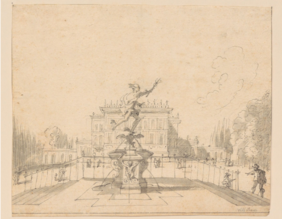Albrecht Haupt lists three entries in his handwritten catalogue for the collection under the name of Wilhelm Baur, which refer to four drawings, including the sheet "Fontäne mit Merkur" presented here. Although Lieselotte Vossnack published the drawing in 1966 (cat. Herrenhausen 1966 p. 60, cat. III/13), it was not taken into account in the subsequent research on Baur.
Set in the centre of the sheet is the figure of the winged messenger of the gods, Mercury, whose striding and soaring posture immediately evokes the famous sculpture by Giambologna. The fountain to which it belongs is placed on a platform that can be reached from both sides by several steps. Through a delicate balustrade, one looks out over the hustle and bustle of the garden behind it. A magnificent casino with several stepped and receding extensions forms the end of the scenery.
Johann Wilhelm Baur (1607-1642), a painter and etcher from Strasbourg, trained himself extensively on the works and manner of his Italian artist colleagues during his several years' stay in Italy. He worked up his knowledge of the Italian topography and art in - often ideal - architectural and city views, which he successfully executed in miniature paintings, but which also found their expression in his graphic works of art. The engraver and publisher Melchior Küsel (1626-1683) titled the etching "Eine Fontana in dem Lustgarten des Card. de Medici", which shows an almost identical composition in the mirror sense. It was published in his "Joannis Guilielmi Baurn Iconographia ..." in Augsburg 1670, vol. 4, plate 2. The motif as well as its later identification can be attributed to the inventiveness of their respective creators.
Two drawing albums, which are kept in the Princely Collections Liechtenstein, contain a large part of Baur's hand drawings, which Küsel used as models for his etchings. A drawing of the Mercury Fountain is also preserved there and most probably the model for Küsel. How the Hanoverian drawing is to be classified in the work process remains unclear until now; a copy after the etching is to be ruled out, however, since its orientation corresponds to the drawing in Vaduz and not to the mirrorsensed etching.
Birte Rubach

